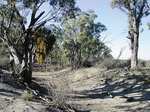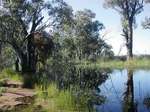River Murray faces grim future
 Environmental Science Environmental Science
The River Murray is in crisis, receiving 80% less water than it needs to maintain its ecological balance and prevent it salting up, according to a University of Adelaide PhD student. Anne Jensen, from the School of Earth & Environmental Sciences, said the river was declining in front of our eyes and there was very little hope of repairing the damage. "The community needs to understand the consequences - if the river system is in trouble then our water supplies are also in trouble. It needs water just as much as people do," Mrs Jensen said. Mrs Jensen is one of several University of Adelaide academics working specifically on River Murray projects, looking at the long-term future of the river, which provides 50% of Adelaide's water needs. "Since 2001 our scientists have been saying that the river needs a minimum of 1500 gigalitres returned to it from the Murray catchment each year. Ideally, 3000 gigalitres are needed for a high chance of recovery. In 2007 we are struggling to return even 20% of the minimum needed," she said. "We need enough water to keep the river and floodplain in balance, to prevent algal blooms and salt accumulation, as well as maintaining the health of our river red gums and other species. A zero allocation for the environment is just as devastating as for irrigators, with a decline in quality for all water users. "To maintain the river's health we need to use less water through more efficient irrigation and industry use, recycling, more effective use of rainwater and reduced demand for public parks and gardens. "Some people believe that using less water will mean a lower quality of life, but that's not true. It just means being smarter in our water use, valuing it more as a resource, and adapting better to living in a dry country," she said. Mrs Jensen said most of the magnificent red gums along the River Murray would not survive and many plant and animal species would be lost unless more water was delivered back to the system. "The Coorong - a wetland of international importance - has become so salty that only a handful of species can live there now and the Chowilla floodplain is also threatened. It is crucial that we listen to the scientists and get smarter with our water use." Story by Candy Gibson
To find out more about Environmental Science at the University of Adelaide, visit Open Day on Sunday 26 August. www.adelaide.edu.au/openday
|






